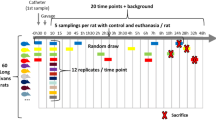Abstract
Organochlorine residues (OCR)2 are poorly soluble in water and are transported in the organism bound by the blood components. The distribution among blood fractions (cells/plasma, lipoproteins/rest of plasma proteins) were variable depending on the residue (HCB,p p′-DDE, HCH, Aroclor® 1260, PCP) and on the species (rat, man). Differences were not found betweenin vivo (after oral single dosing) andin vitro (blood incubation) experiments. Results indicated a high affinity of organochlorine residues for lipo-proteins; however, binding to blood carriers was very weak as demonstrated by the rapid release of residues by elution through a reverse phase column. The effects of residue binding to blood components on the distribution kinetics to tissues are discussed.
Similar content being viewed by others
Abbreviations
- CM:
-
chylomicrons
- CMC:
-
carboxymethyl cellulose
- DDE:
-
dichlorodiphenyl dichloroethene
- HCB:
-
hexachlorobenzene
- HCH:
-
hexachlorocyclohexane
- HDL:
-
high density lipoproteins
- LDL:
-
low density lipoproteins
- OCR:
-
organochlorine residues
- PCBs:
-
polychlorinated biphenyls
- PCP:
-
pentachiorophenol
- VLDL:
-
very low density lipoproteins
References
Bertram HP, Kemper FH, Muller C (1986) Hexachlorobenzene content in human whole blood and adipose tissue: Experiences in environmental specimen banking. In Morris CR, Cabral JRP (eds) Hexachlorobenzene: Proceedings of an International Symposium, IARC Scientific Publications, Lyon, p 173
Camps M, Planas J, Gómez-Catalán J, Sabroso M, To-Figueras J, Corbella J (1989) Organochlorine residues in human adipose tissue in Spain. Study of an agrarian area. Bull Environ Contam Toxicol 42:195–201
Carter JW (1985) Effects of dietary PCBs (Aroclor® 1254) on serum levels of lipoprotein cholesterol in Fisher rats. Bull Environ Contam Toxicol 34:427–431
Chen TC, Bradley WA, Gotto AM, Morrisett JD (1979) Binding of the chemical carcinogenp-dimethylamino benzene by human plasma low density lipoproteins. FEBS Let 104:236–240
Corbella J, To-Figueras J, Rodamilans M, Gómez-Catalán J (1986) Mobilization, redistribution and excretion of hexachlorobenzene following food restriction in rats. In Morris CR, Cabral JRP (eds) Hexachlorobenzene: Proceedings of an International Symposium, IARC Scientific Publications, Lyon, p 289
Gallenberg LA, Vodicnik MJ (1987) Potential mechanisms for redistribution of polychlorinated biphenyls during pregnancy and lactation. Xenobiotica 17:299–310
Havel RJ, Eder HA, Bragdon JH (1955) The distribution and chemical composition of ultracentrifugally separated lipoproteins in human serum. J Clin Invest 34:1345–1353
Ihm J, Harmony JAK (1980) Simultaneous transfer of cholesteryl ester and phospholipids by proteins isolated from human lipoprotein-free plasma. Biochem Biophys Res Comm 93:1114–1120
Keenan RW, Kruczek ME, Fischer JB (1977) The binding of H3-dolichol by plasma high density lipoproteins. Biochim Biophys Acta 486:1–9
Maliwal BP, Guthrie FE (1981) Interactions of insecticides with human plasma lipoproteins. Chem-Biol Interactions 35:177–188
Mangelsdorf I, Buff K, Berndt J (1987) Uptake of persistent environmental chemicals by cultured human cells. Biochem Pharmacol 36:2071–2078
Massey JB, Hickson D, She HS, Sparrow JT, Via DP, Gotto AM, Pownall HJ (1984) Measurement and prediction of the rates of spontaneous transfer of phospholipids between plasma lipoproteins. Biochim Biophys Acta 794:274–280
Pohland RC, Counsell RE (1985) The role of high density lipoproteins in the biodistribution of two radioiodinated probes in the rat. Toxicol Appl Pharmacol 77:47–57
Shireman RB (1988) Lipoprotein-mediated transfer of 2,4,5,2′,4′,5′-hexachlorobiphenyl into cultured human cells. Xenobiotica 18:449–457
Soine PJ, Blanke RV, Guzelian PS, Schwartz CC (1982) Preferential binding of chlordecone to the protein and HDL fractions of plasma from humans and other species. J Toxicol Environ Health 9:107–118
To-Figueras J, Rodamilans M, Gómez-Catalán J, Corbella J (1986) Hexachlorobenzene residues in the general population of Barcelona (Spain). In Morris CR, Cabral JRP (eds) Hexachlorobenzene: Proceedings of an International Symposium, IARC Scientific Publications, Lyon, p 147
To-Figueras J, Gómez-Catalán J, Rodamilans M, Corbella J (1988) Mobilization of stored HCB andp p′-DDE during partial starvation in rats. Toxicol Lett 42:79–86
Veierov D, Aharonson N (1978) Simplified fat extraction with sulfuric acid as cleanup procedure for residue determination of chlorinated hydrocarbons. J Assoc Offic Anal Chem 61:253–260
Villeneuve DC (1975) The effect of food restriction on the redistribution of hexachlorobenzene in the rat. Toxicol Appl Pharmacol 31:313–319
Vomachka MS, Vodicnik MJ, Lech JJ (1983) Characteristics of 2,4,5,2′,4′,4′-hexachlorobiphenyl distribution among lipoproteinsin vitro. Toxicol Appl Pharmacol 70:350–361. (1984) Transport of 2,4,5,2′,4′,5′-hexachlorobiphenyl by lipoproteinsin vivo. Toxicol Appl Pharmacol 74:70–77
Yang RSH, Coulston F, Golberg L (1975) Binding of hexachlorobenzene to erythrocytes: Species variation. Life Sci 17:545–549
Author information
Authors and Affiliations
Rights and permissions
About this article
Cite this article
Gómez-Catalán, J., To-Figueras, J., Rodamilans, M. et al. Transport of organochlorine residues in the rat and human blood. Arch. Environ. Contam. Toxicol. 20, 61–66 (1991). https://doi.org/10.1007/BF01065329
Received:
Revised:
Issue Date:
DOI: https://doi.org/10.1007/BF01065329




